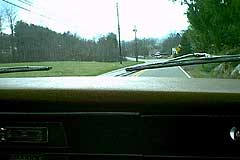
Most of us take windshield wipers for granted until we need them. Then you turn them on only to find that they streak, smear, chatter, squeal or scratch as they move back and forth before our eyes. Depending on where you live, windshield wipers can last a year or two with a bit of care. But they should be inspected frequently and replaced if required. It is more pleasurable to change wiper blades on a sunny afternoon in your driveway than on a rainy night at the side of the road.
A good time for inspection is while washing your vehicle. The rubber edges have to be sharp, smooth, straight and clean so they can serve as a squeegee to remove rain, snow, dirt, bugs and bird droppings. The rubber has to be flexible so the blade can flip over after wiping in one direction to wipe in the other direction. Torn or cracked blades should be replaced immediately.
The environment is the wiper's biggest enemy. Ultraviolet solar radiation, ozone and airborne chemicals degrade the rubber compound affecting the rubber's ability to retain its shape and flexibility. Dirt accumulation can decrease flexibility as well as scratching the windshield.
Make sure to inspect the entire wiper assembly - blade, frame and arm. Bent, corroded or twisted arms should be replaced. So should frames that do not secure the blade. If the wiper blade comes loose it can severely scratch the windshield. The spring tension of the wiper arm can weaken with age so aerodynamic forces will lift the blade off the windshield slightly at high speeds causing chattering, skipping or smearing.
Wipers need exercise. In drier parts of country where wipers are used infrequently, they can stiffen and set in the position. This is especially true with vehicles that are parked for months on end. At a minimum, wipers should be operated at least every couple of weeks.
Do not operate wipers on a dry windshield. Turn them on after you have used the windshield- washers or sprayed the windshield with the garden hose. A good time to run the wipers is after washing the vehicle. Make sure the washer reservoir has fluid in it before turning on the wipers. This is a good time to fill up the reservoir as well as making sure it is working properly.
You can prolong the life of wiper blades by keeping them clean. Clean once a month with a clean rag and windshield washer fluid. Rub along the blade to remove debris and contaminants. There are commercial wiper conditioners available for cleaning and restoring flexibility.
If replacement is required, you can usually get by with a blade refill. Replacement is quite simple and can be done with a pair of pliers and a small screwdriver. Usually, the replacements are "universal" designs with an assortment of mounting adapters in the package. Read the instructions and use the right pieces for your vehicle.
Measure the length of the blade and study the way the blade attaches to the wiper arm before heading to the parts store. Better yet, take the whole assembly with you so you can match it with he replacements. Buy high quality replacements rather than cheap ones, the price differential is quite small. Some of the cheap replacements may not flex exactly to conform to the complex contours of wraparound windshields leaving areas that are not cleared. In some cases you might have to buy replacements from the dealer rather than use universal refills to get the proper operation. Also cheap arm and frame replacements may not provide enough spring tension to prevent lifting at higher speeds.
On many vehicles, the wiper arms will stand away from the windshield making the replacement job a bit easier. On others spring tension will snap the arm back damaging the windshield if you are not careful. If you have hidden wipers, move the blades to a more convenient location. Wet the windshield to prevent scratching, turn on the ignition and then switch on the wipers. Turn off the ignition in mid-stroke.
If you live in parts of the country where winters are particularly brutal you might consider special-purpose winter blades. They have features like larger profiles to "plow" snow off the windshield, rubber compounds that keep them flexible at sub-zero temperatures, and prevent snow and ice from accumulating on the blade. Also they are bit more heavy duty to stand up under harsh winter conditions.




